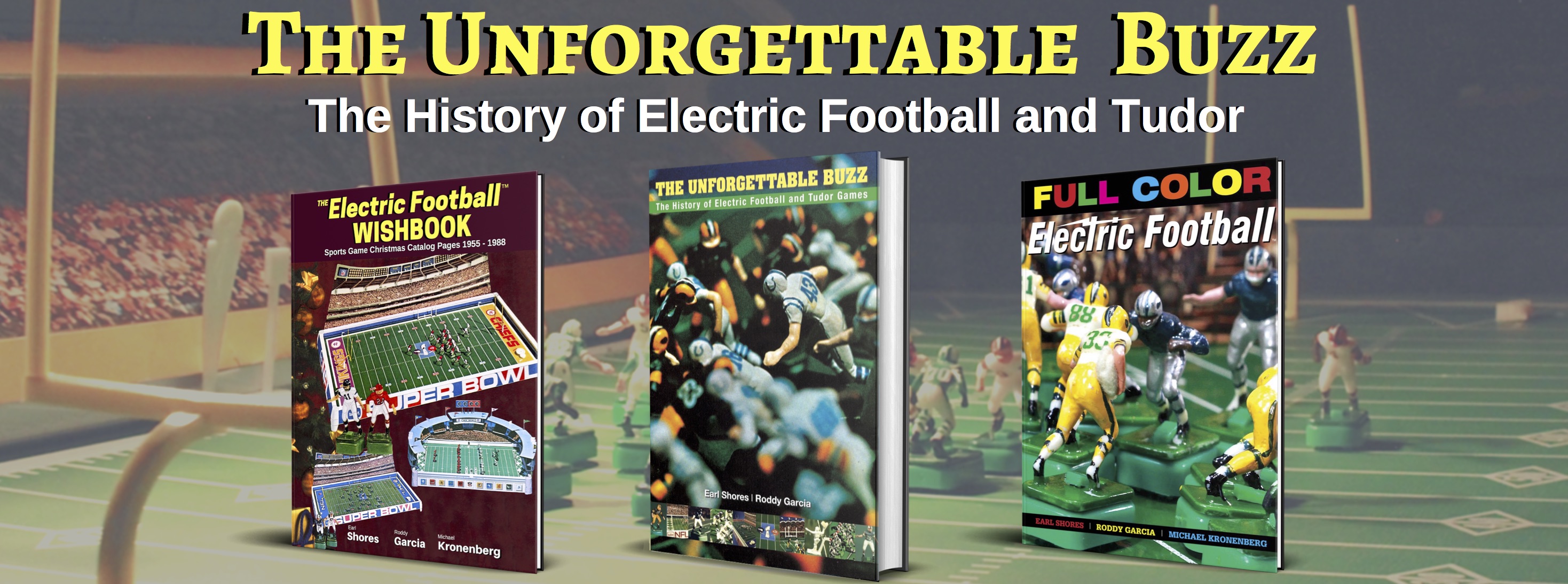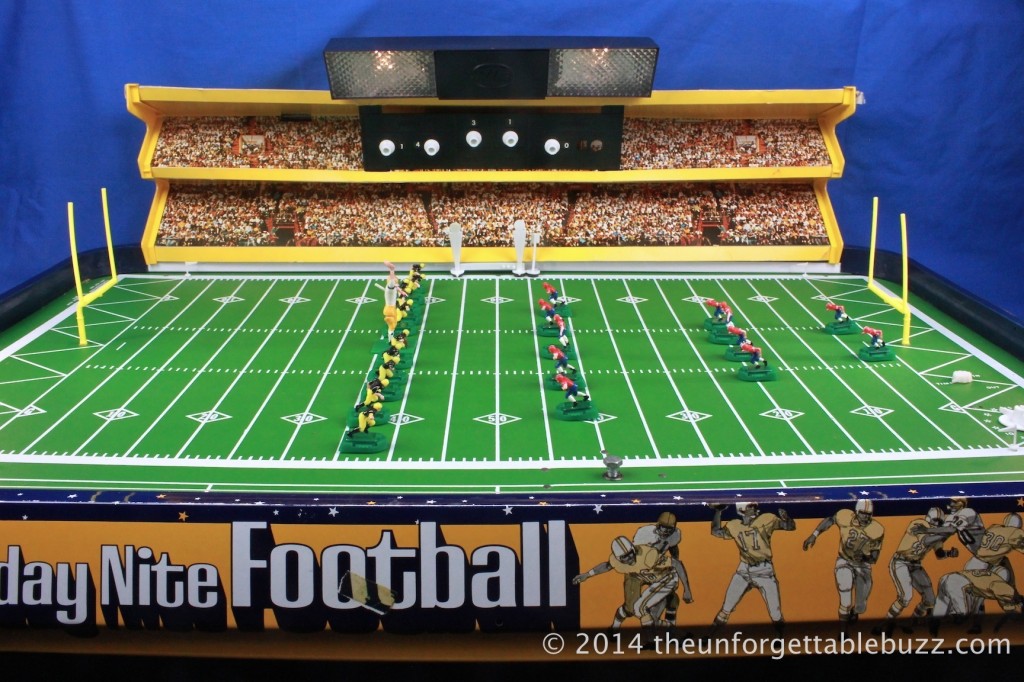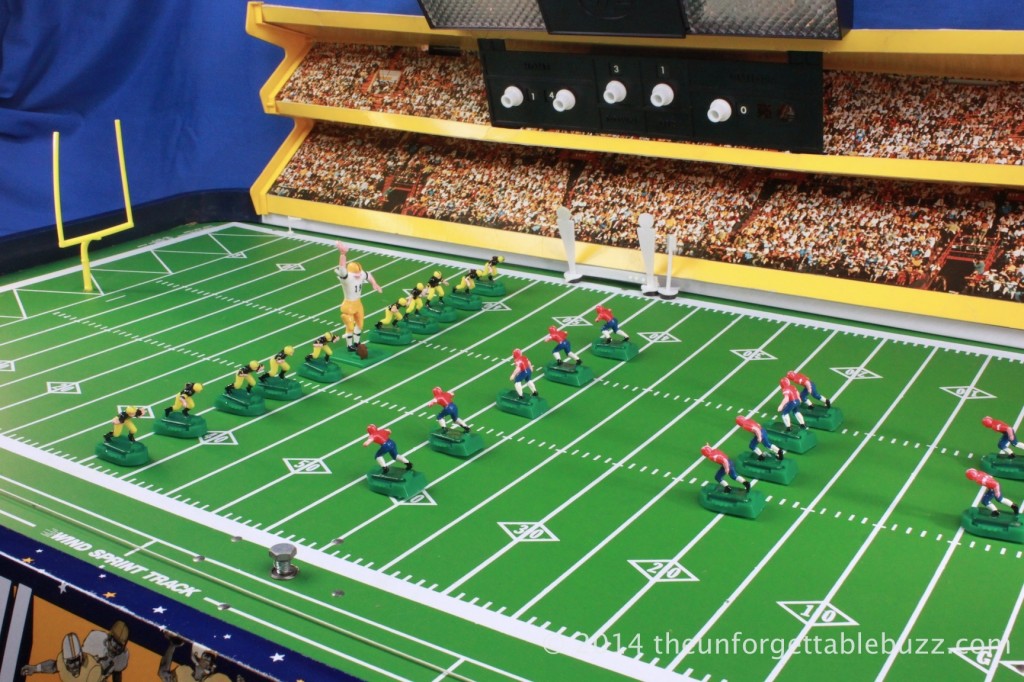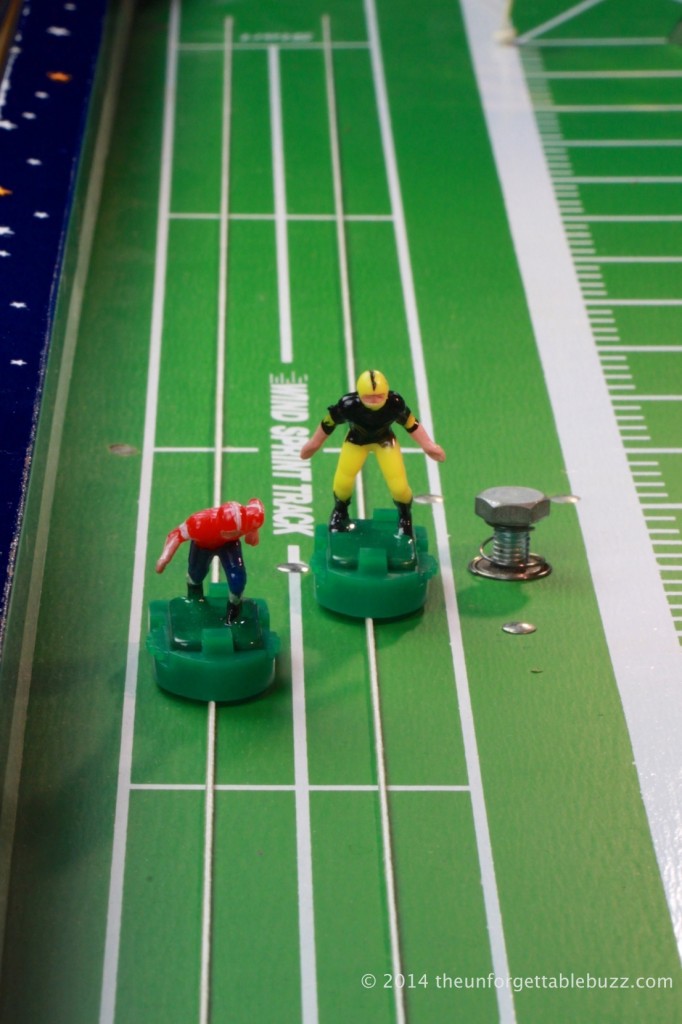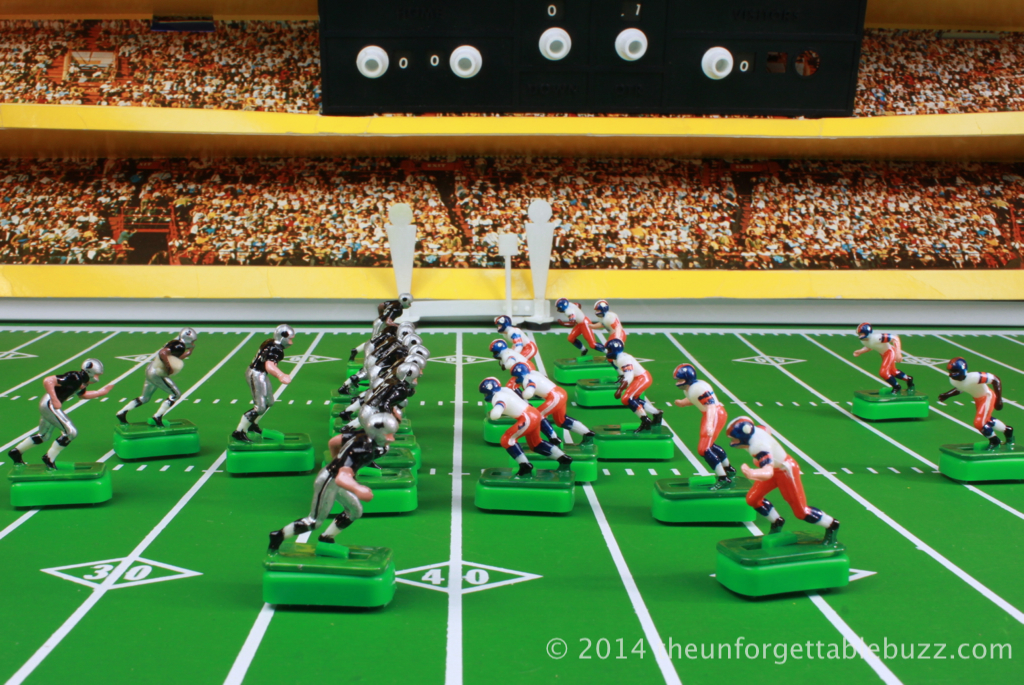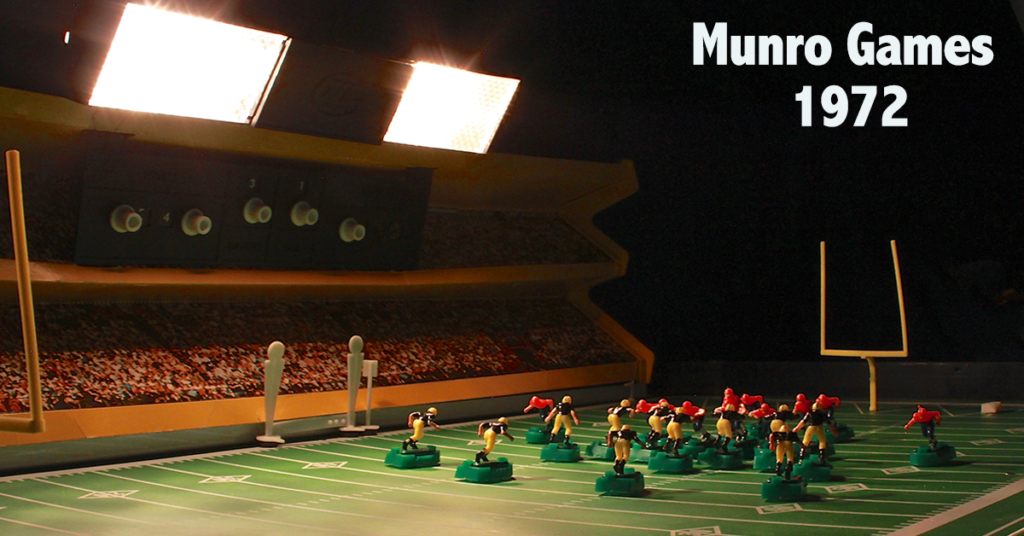 The Electric Football Game Top 20 Countdown continues with one of the “grandest” games ever commercially produced at No. 4 — the 1972 Munro Day/Nite Electric Football game.
The Electric Football Game Top 20 Countdown continues with one of the “grandest” games ever commercially produced at No. 4 — the 1972 Munro Day/Nite Electric Football game.
The Day/Nite game story really begins in the 1960’s, when Tudor and Gotham were competing for Electric Football dominance. Both companies’ games evolved through the decade, becoming bigger, brighter, and more elaborate with each passing year. The Gotham Big Bowl (1965-1968), the Tudor “Accordion” Game (1966), the Gotham Super Dome (1969), and Tudor No. 633 Super Bowl are all prime examples of this evolution.
A parallel evolution could be found in the swelling profits that Electric Football was providing for toy makers (Tudor at least). It was this profitability that enticed Coleco and Munro Games onto the vibrating gridiron in the early 1970’s. As the number of companies making Electric Football doubled from two in 1969 to four in 1971, the number of different Electric Football models on toy store shelves more than doubled.
The “arms race” of Electric Football features continued as Coleco and Munro tried to define themselves. (Tudor was already well-defined and very profitable thanks to its NFL line). Coleco invented Command Control, and even put legs and a faux woodgrain finish on a $30 “Rec Room” model in 1971.
Munro had a rocky Electric Football debut in 1971, and came into 1972 determined to make a “statement.” There’s no argument that they did just that with the elaborate and awe-inspiring Day/Nite Electric Football game.
Munro’s designers took a look what had been done in Electric Football and borrowed the “best” of what they saw: painted 3-D players, painted 3-D quarterbacks, directional bases, and a double-decked 3-D grandstand.
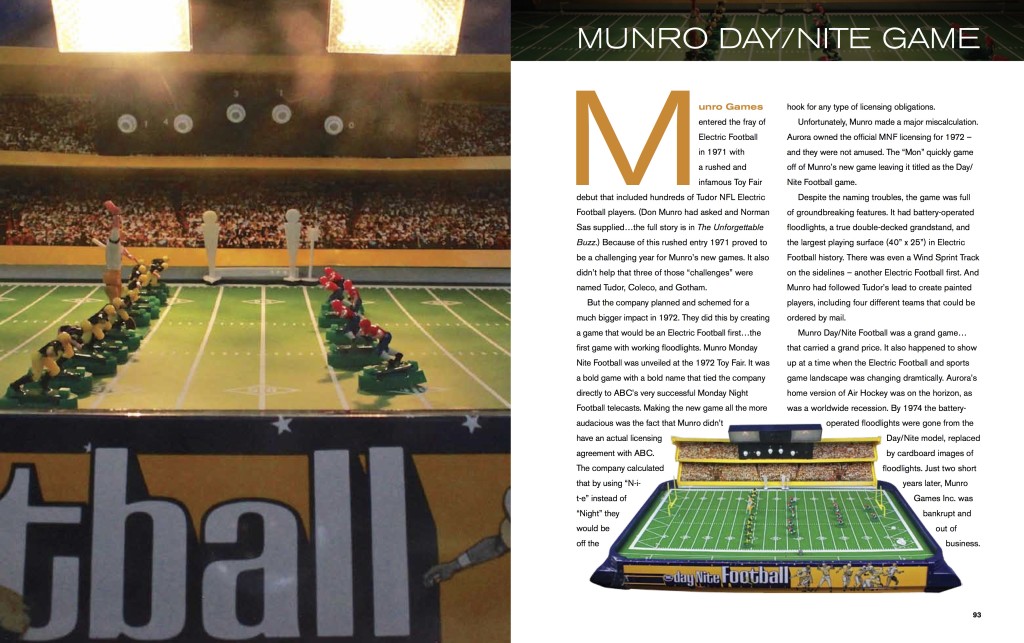
The Munro Day/Nite Section in Full Color Electric Football
They also took stock what hadn’t been done before, and were given the “go ahead” to think big. The result was the biggest Electric Football playing surface ever commercially produced (40” x 25”), which included the innovation of a sideline Wind Sprint track. And of course, they came up with the feature that clearly separated Munro from every other Electric Football maker — and every other Electric Football game made up until that point. A pair of grandstand-mounted battery-operated floodlights. Munro had created the first ever “night” Electric Football maker.
While all of these features add up to a pretty special Electric Football game, it needs to be understood that it didn’t automatically have to be a “great” game. All credit for that goes to Munro Games, whose designers had a lot of experience making rod hockey games. They knew how to build sports action games and didn’t cut corners. The result is, nothing about the game feels cheap, and indeed, you can almost sense the pride the designers had in creating it. It’s a truly beautiful game when set up. The fit and finish of the game rival the work Tudor was doing at the time.
In playing the game…the lights weren’t all that bright, being that they were powered by 2 “C” batteries. But you could turn off all the lights in a room and actually play the game solely by floodlight (young eyes can “see” anything). The field had an understated yet classy marking pattern, and was set off by a realistic green grass color. Helping the realism was the roughest surface ever seen in Electric Football (if the players actually tackled each other they would have gotten rug burns). The field was also made from the thickest piece of fiberboard ever seen in Electric Football, resulting in a “buzz” that was the loudest in all of Electric Football.
But…the problem with making a game this elaborate, and making it as solid as Munro did, was that it was always going to be a very expensive purchase. Most retailers priced the game around the $20 mark, with Sears selling an exclusive model with legs for $24.99. This was significantly more than even Tudor’s large NFL models cost.
Because of its hefty price tag, the game didn’t sell well at all in 1972. It was large and expensive, and took up a lot of shelf space, holding onto that space well past the all-important Christmas selling season. So in 1973, even with Joe Namath’s endorsement now on the Day/Nite model, most retailers weren’t interested in carrying a costly oversized non-seller.
The best illustration of the Day/Nite game’s plight was its appearance in Sears Surplus Stores during the fall of 1973 (see page 467 of The Unforgettable Buzz). After just a year on the market, the game was already a clearance item. And 1973 would prove to be the last year for a Munro Day/Nite model with working floodlights.
There is much, much more about the Day/Nite model and Munro’s rise and fall in The Unforgettable Buzz, including the story of how the game was originally named “Monday Nite Football” (Chapter 26). It was truly ahead of its time, and really the culmination of the game evolution that Gotham started with their G-1500 in 1961.
Sitting proudly at No. 4 on our Countdown, it’s the 1972 Munro Day/Nite Electric Football game.
Earl, Roddy, & MK
